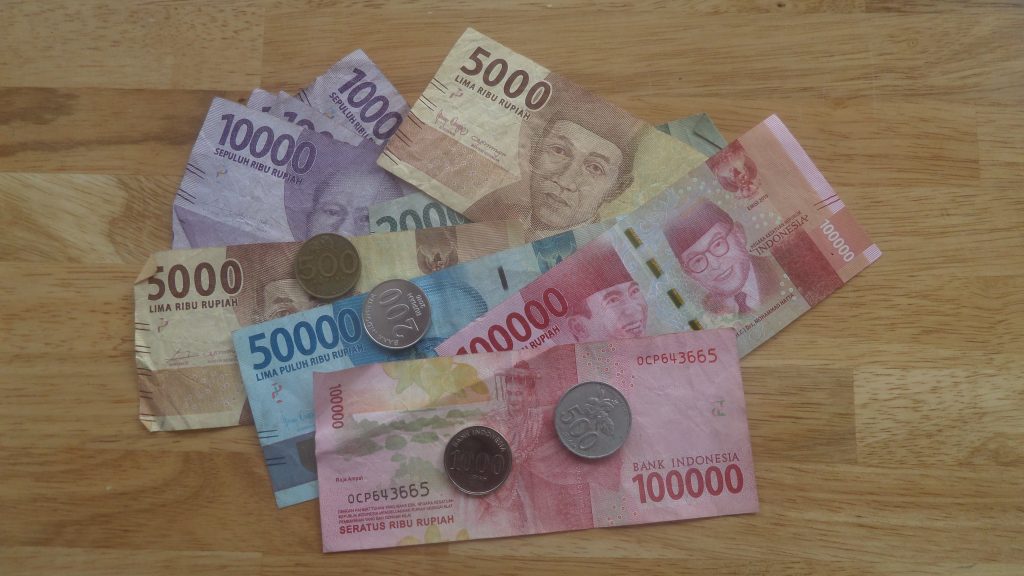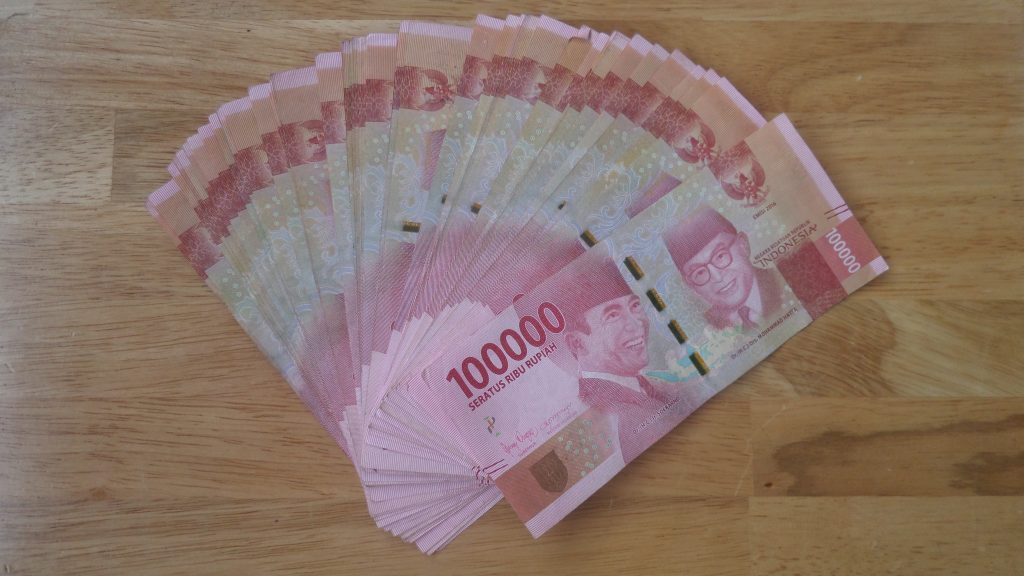
In this post, I will give you some practical tips related to money and banks in Indonesia. This is a series of posts, you can find similar tips about other countries I have visited in the “money” category section of my blog.
1. Banknotes and coins in Indonesia
The Indonesian rupee has 2.000, 5.000, 10.000, 20.000, 50.000 and 100.000 rupee banknotes, but you can come across a few one thousand notes, too, though these are rarely used. Although those zeros could be hard to follow, the colours will help you distinguish them very soon. To avoid mistakes, I always kept the 50k and 100K notes separately from the rest in my wallet.
Coins are also widely used. There are 200, 500 and 1000 rupee coins. It is easy to accumulate them, so try to use them whenever you can, although it has happened several times that in various shops, they just didn’t care about less than one thousand, and they rounded the amount up or down. You could do the same when paying – you should of course always round it up rather than down.
You don’t need to be afraid that they will not have enough change if you pay with a hundred thousand banknote – after all, it is not that much even in Indonesia. For a simple meal, you will sometimes pay 30k+. One exception, for some reason, was Grab bikes, which cost between 8 and 15 in most of the cases when I ordered them, and it happened several times that the driver didn’t have change. In that case, you need to ask someone, like a street vendor or a shop nearby, to break your 50k or 100k note.
Tipping is not expected in Indonesia, unless you are in a very good restaurant or a bar frequented by foreign tourists.
1. Changing money in Indonesia
I rarely changed money in Indonesia, but when I did, I got a decent rate. Also, I didn’t see an awful lot of difference in rates, but if you change a lot of money, shop around a little. At most airports when you arrive, there are likely to be several money changers, so compare their rates before you use one of them.
In less touristy places (see Padang, for example), you are not likely to see a lot of money changers. If you can’t find any, just walk into a bank, where they can change your foreign currency. But take into consideration the business hours, which is normally 8am to 5pm. In Bali and other famous destinations, you will of course have more than enough options to change whatever currency into Indonesian rupees.
3. ATMs
You will find ATMs very easily almost everywhere in Indonesia, except the small villages and very small towns. If you plan to go to such places (see my trip to the Mentawai villages, for example), stock up on cash before you leave, in the nearest town or city.
The maximum amount of cash you can withdraw from most ATMs in most countries in Southeast Asia will be shamefully low. In Indonesia, most of them will have a limit of 1.2 million to 2 million. 1 million IDR equals to about 65 euros, which is very easy to spend.
If you use a decent bank, the fees may be not very high, but my bank charges me not less than ten euros for every single ATM use outside of Europe. Now this will be more than ten percent of the amount I could withdraw, and add to that the extra fee that the company operating the ATM charges on top of the bank’s fees. (I know, you are now asking: “why TF don’t you change banks?”, but all the other banks in my country charge this much or more, so the correct question should be: “Why TF don’t you change your home country?” – and that sounds like a very good question…)
In Indonesia, I found that the only bank that has ATMs which will let you withdraw a maximum of 3 million rupees is Maybank. It is a chain that has branches all over Indonesia (and Malaysia, its home country, plus Singapore and the Philippines), so wherever you are, try to find a Maybank ATM. But make sure the ATM spits out 100k banknotes, because the 3M is only possible in that case. (There are ATMs which dispense 50k banknotes, too).
Special advice: I strongly recommend that you should only use an ATM that is attached to an actual bank office/branch, and only during business hours when there are office workers and security guards who can help you, should anything go wrong.
What can go wrong? The biggest danger is that the ATM may swallow your card. In such cases, you may get immediate help from the bank staff, and if you are lucky, you may get your card back after a few minutes, or at least not long after it has been eaten by the machine.
Another thing to consider is fraud: it is much less likely that an ATM inside a bank building is tampered with (cameras or other devices recording your card data and your PIN code etc.), and there is little chance that some bystanders watch you and wait for you after you have withdrawn a bunch of large banknotes.

4. Paying with cards or cash in Indonesia
In Indonesia, you primarily pay cash. They accept cards at many places now, and the number is increasing. Even in small shops, not to mention supermarkets, hotels and bigger shops, you will be able to pay with your card, either Visa or Mastercard.
However, I am not comfortable with using my bank card just about anywhere, when I am outside Europe. I have already learnt it the hard way, that you should limit your card usage as much as possible, and only use it where it is most probably safe. Using you card in large supermarkets, especially if you see a lot of local customers doing the same, is probably safer than paying with you card in a small, shabby looking shop. This is one thing why I stick to cash (which I have to withdraw for a very high fee, I know).
Another reason why you may consider paying cash is because hotels usually charge you extra if you want to pay by card. This may vary between 3 and 5 percent, which could be a lot – perhaps more than what you pay for using the ATM.
You can also ask the hotel if you can pay via a bank transfer. This also costs you money, of course, but there are now companies like Transferwise, which help you reduce the fee, and the exchange rate is also the best.
